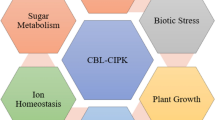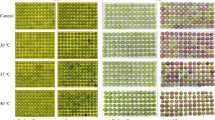Abstract
Laccases, which belong to the blue copper oxidase enzyme family, oxidize many organic and inorganic compounds. The laccase-encoding genes DcLac1 and DcLac2 were isolated from the economically important tuberous root carrot, and their proteins were successfully expressed and purified using the Escherichia coli expression system BL21(DE3). DcLac1 and DcLac2 had molecular masses of approximately 64 and 61.9 kDa, respectively. With 2,2′-azinobis-(3-ethylbenzthiazoline-6-sulfonate acid) as the substrate, DcLac1 and DcLac2 had K m values of 3.9043 and 1.255 mM, respectively, and V max values of 54.0832 and 81.7996 μM mg−1 min−1, respectively. Moreover, DcLac1 and DcLac2 had optimal pH values of 2.8 and 2.6, respectively, and optimal temperatures of 45 and 40 °C, respectively. The activities of the two enzymes were promoted by Ca2+, Mg2+, Cu2+, and Na+ but inhibited by Fe2+, Zn2+, Mn2+, K+, SDS, and EDTA. Expression profiles showed that the two DcLac genes had almost identical responses to high and low temperature stresses but different responses to salt, drought, and metal stresses. This study provided insights into the characteristics and tolerance response mechanisms of laccase in carrot.





Similar content being viewed by others
Abbreviations
- ABTS:
-
2,2′-Azinobis-(3-ethylbenzthiazoline-6-sulfonate acid)
- SDS:
-
Sodium dodecyl sulfate, sodium salt
- EDTA:
-
Ethylene diamine tetraacetic acid
- qRT-PCR:
-
Quantitative real-time PCR
- SDS-PAGE:
-
Sodium dodecyl sulfate, sodium salt-polyacrylamide gel electrophoresis
- McIlvaine buffer:
-
Citric acid–Na2HPO4 buffer
References
Bowman MJ, Simon PW (2013) Quantification of the relative abundance of plastome to nuclear genome in leaf and root tissues of carrot (Daucus carota L.) using quantitative PCR. Plant Mol Biol Rep 31(4):1040–1047
Claus H (2003) Laccases and their occurrence in prokaryotes. Arch Microbiol 179(3):145–150. doi:10.1007/s00203-002-0510-7
Brouwers GJ, de Vrind JP, Corstjens PL, Cornelis P, Baysse C, de Vrind-de Jong EW (1999) cumA, a gene encoding a multicopper oxidase, is involved in Mn2+ oxidation in Pseudomonas putida GB-1. Appl Environ Microbiol 65(4):1762–1768
Grass G, Rensing C (2001) CueO is a multi-copper oxidase that confers copper tolerance in Escherichia coli. Biochem Biophys Res Commun 286(5):902–908. doi:10.1006/bbrc.2001.5474
Mayer AM, Staples RC (2002) Laccase: new functions for an old enzyme. Phytochemistry 60(6):551–565
Ducros V, Brzozowski AM, Wilson KS, Brown SH, Ostergaard P, Schneider P, Yaver DS, Pedersen AH, Davies GJ (1998) Crystal structure of the type-2 Cu depleted laccase from Coprinus cinereus at 2.2 A resolution. Nat Struct Biol 5(4):310–316
Ferraroni M, Duchi I, Myasoedova NM, Leontievsky AA, Golovleva LA, Scozzafava A, Briganti F (2005) Crystallization and preliminary structure analysis of the blue laccase from the ligninolytic fungus Panus tigrinus. Acta Crystallogr Sect F Struct Biol Cryst Commun 61(Pt 2):205–207. doi:10.1107/S1744309104034463
Claus H (2004) Laccases: structure, reactions, distribution. Micron 35(1–2):93–96. doi:10.1016/j.micron.2003.10.029
McCaig BC, Meagher RB, Dean JF (2005) Gene structure and molecular analysis of the laccase-like multicopper oxidase (LMCO) gene family in Arabidopsis thaliana. Planta 221(5):619–636. doi:10.1007/s00425-004-1472-6
Coll PM, Perez P, Villar E, Shnyrov VL (1994) Domain structure of laccase I from the lignin-degrading basidiomycete PM1 revealed by differential scanning calorimetry. Biochem Mol Biol Int 34(6):1091–1098
Giardina P, Palmieri G, Scaloni A, Fontanella B, Faraco V, Cennamo G, Sannia G (1999) Protein and gene structure of a blue laccase from Pleurotus ostreatus1. Biochem J 341(Pt 3):655–663
Decker H, Terwilliger N (2000) Cops and robbers: putative evolution of copper oxygen-binding proteins. J Exp Biol 203(Pt 12):1777–1782
Garavaglia S, Cambria MT, Miglio M, Ragusa S, Iacobazzi V, Palmieri F, D’Ambrosio C, Scaloni A, Rizzi M (2004) The structure of Rigidoporus lignosus laccase containing a full complement of copper ions, reveals an asymmetrical arrangement for the T3 copper pair. J Mol Biol 342(5):1519–1531. doi:10.1016/j.jmb.2004.07.100
Sterjiades R, Dean JF, Eriksson KE (1992) Laccase from sycamore maple (Acer pseudoplatanus) polymerizes monolignols. Plant Physiol 99(3):1162–1168
Bao W, O’Malley DM, Whetten R, Sederoff RR (1993) A laccase associated with lignification in loblolly pine xylem. Science 260(5108):672–674. doi:10.1126/science.260.5108.672
Zhao Q, Nakashima J, Chen F, Yin Y, Fu C, Yun J, Shao H, Wang X, Wang ZY, Dixon RA (2013) Laccase is necessary and nonredundant with peroxidase for lignin polymerization during vascular development in Arabidopsis. Plant Cell 25(10):3976–3987. doi:10.1105/tpc.113.117770
Bailey MR, Woodard SL, Callaway E, Beifuss K, Magallanes-Lundback M, Lane JR, Horn ME, Mallubhotla H, Delaney DD, Ward M, Van Gastel F, Howard JA, Hood EE (2004) Improved recovery of active recombinant laccase from maize seed. Appl Microbiol Biotechnol 63(4):390–397. doi:10.1007/s00253-003-1362-z
Boudet A-M (2000) Lignins and lignification: selected issues. Plant Physiol Biochem 38(1):81–96
Butt VS (1980) Direct oxidases and related enzymes. In: Metabolism and respiration, vol 2. Academic Press, New York, pp 81–123
Albersheim P (1976) The primary cell wall. In: Bonner J, Varner JE (eds) Plant biochemistry, 3rd edn. Academic Press, New York, pp 225–274
Holker U, Dohse J, Hofer M (2002) Extracellular laccases in ascomycetes Trichoderma atroviride and Trichoderma harzianum. Folia Microbiol 47(4):423–427
Fry SC (1982) Phenolic components of the primary cell wall. Feruloylated disaccharides of d-galactose and l-arabinose from spinach polysaccharide. Biochem J 203(2):493–504
Dean JF, Eriksson K-EL (1994) Laccase and the deposition of lignin in vascular plants. Holzforsch Int J Biol Chem Phys Technol Wood 48(s1):21–33
Leonowicz A, Cho NS, Luterek J, Wilkolazka A, Wojtas-Wasilewska M, Matuszewska A, Hofrichter M, Wesenberg D, Rogalski J (2001) Fungal laccase: properties and activity on lignin. J Basic Microbiol 41(3–4):185–227
Thurston CF (1994) The structure and function of fungal laccases. Microbiology 140(1):19–26
Assavanig A, Amornikitticharoen B, Ekpaisal N, Meevootisom V, Flegel TW (1992) Isolation, characterization and function of laccase from Trichoderma. Appl Microbiol Biotechnol 38(2):198–202
Baldrian P (2006) Fungal laccases—occurrence and properties. FEMS Microbiol Rev 30(2):215–242
Eggert C, Temp U, Eriksson K-EL (1997) Laccase is essential for lignin degradation by the white-rot fungus Pycnoporus cinnabarinus. FEBS Lett 407(1):89–92
Salas SD, Bennett JE, Kwon-Chung KJ, Perfect JR, Williamson PR (1996) Effect of the laccase gene CNLAC1, on virulence of Cryptococcus neoformans. J Exp Med 184(2):377–386
Kiiskinen LL, Viikari L, Kruus K (2002) Purification and characterisation of a novel laccase from the ascomycete Melanocarpus albomyces. Appl Microbiol Biotechnol 59(2–3):198–204. doi:10.1007/s00253-002-1012-x
Fink-Boots M, Malarczyk E, Leonowicz A (1999) Increased enzymatic activities and levels of superoxide anion and phenolic compounds in cultures of basidiomycetes after temperature stress. Acta Biotechnol 19(4):319–330
Jarosz-Wilkolazka A, Malarczyk E, Pirszel J, Skowronski T, Leonowicz A (2002) Uptake of cadmium ions in white-rot fungus Trametes versicolor: effect of Cd(II) ions on the activity of laccase. Cell Biol Int 26(7):605–613
Xu ZS, Tan HW, Wang F, Hou XL, Xiong AS (2014) CarrotDB: a genomic and transcriptomic database for carrot. Database. doi:10.1093/database/bau096
Lin Y, Zhang Z, Tian Y, Zhao W, Zhu B, Xu Z, Peng R, Yao Q (2013) Purification and characterization of a novel laccase from Coprinus cinereus and decolorization of different chemically dyes. Mol Biol Rep 40(2):1487–1494. doi:10.1007/s11033-012-2191-x
Yoshida H (1883) LXIII.—chemistry of lacquer (Urushi). Part I. Communication from the chemical society of Tokio. J Chem Soc Trans 43:472–486
Cass AE, Hill HA (1980) Copper proteins and copper enzymes. In: Ciba Foundation Symposium, vol 79, pp 71–91
Alexandre G, Zhulin IB (2000) Laccases are widespread in bacteria. Trends Biotechnol 18(2):41–42
Sanchez-Amat A, Lucas-Elío P, Fernández E, García-Borrón JC, Solano F (2001) Molecular cloning and functional characterization of a unique multipotent polyphenol oxidase from Marinomonas mediterranea. Biochim Biophys Acta (BBA) Protein Struct Mol Enzymol 1547(1):104–116
Thomas B, Yonekura M, Morgan T, Czapla T, Hopkins T, Kramer K (1989) A trypsin-solubilized laccase from pharate pupal integument of the tobacco hornworm, Manduca sexta. Insect Biochem 19(7):611–622
Parkinson N, Smith I, Weaver R, Edwards JP (2001) A new form of arthropod phenoloxidase is abundant in venom of the parasitoid wasp Pimpla hypochondriaca. Insect Biochem Mol Biol 31(1):57–63
Sun J, Peng RH, Xiong AS, Tian Y, Zhao W, Xu H, Liu DT, Chen JM, Yao QH (2012) Secretory expression and characterization of a soluble laccase from the Ganoderma lucidum strain 7071-9 in Pichia pastoris. Mol Biol Rep 39(4):3807–3814. doi:10.1007/s11033-011-1158-7
Bao W, Peng R, Zhang Z, Tian Y, Zhao W, Xue Y, Gao J, Yao Q (2012) Expression, characterization and 2,4,6-trichlorophenol degradation of laccase from Monilinia fructigena. Mol Biol Rep 39(4):3871–3877. doi:10.1007/s11033-011-1166-7
Lu L, Zhao M, Zhang BB, Yu SY, Bian XJ, Wang W, Wang Y (2007) Purification and characterization of laccase from Pycnoporus sanguineus and decolorization of an anthraquinone dye by the enzyme. Appl Microbiol Biotechnol 74(6):1232–1239. doi:10.1007/s00253-006-0767-x
Wang HX, Ng TB (2004) A novel laccase with fair thermostability from the edible wild mushroom (Albatrella dispansus). Biochem Biophys Res Commun 319(2):381–385. doi:10.1016/j.bbrc.2004.05.011
Park KM, Park SS (2008) Purification and characterization of laccase from basidiomycete Fomitella fraxinea. J Microbiol Biotechnol 18(4):670–675
Shin KS, Lee YJ (2000) Purification and characterization of a new member of the laccase family from the white-rot basidiomycete Coriolus hirsutus. Arch Biochem Biophys 384(1):109–115. doi:10.1006/abbi.2000.2083
Cambria M, Cambria A, Ragusa S, Rizzarelli E (2000) Production, purification, and properties of an extracellular laccase from Rigidoporus lignosus. Protein Exp Purif 18(2):141–147. doi:10.1006/prep.1999.1126
Zhu MJ, Du F, Zhang GQ, Wang HX, Ng TB (2013) Purification a laccase exhibiting dye decolorizing ability from an edible mushroom Russula virescens. Int Biodeterior Biodegrad 82:33–39. doi:10.1016/j.ibiod.2013.02.010
Forootanfar H, Faramarzi MA, Shahverdi AR, Yazdi MT (2011) Purification and biochemical characterization of extracellular laccase from the ascomycete Paraconiothyrium variabile. Bioresour Technol 102(2):1808–1814. doi:10.1016/j.biortech.2010.09.043
Li M, Zhang G, Wang H, Ng T (2010) Purification and characterization of a laccase from the edible wild mushroom Tricholoma mongolicum. J Microbiol Biotechnol 20(7):1069–1076
Wu YR, Luo ZH, Kwok-Kei Chow R, Vrijmoed LL (2010) Purification and characterization of an extracellular laccase from the anthracene-degrading fungus Fusarium solani MAS2. Bioresour Technol 101(24):9772–9777. doi:10.1016/j.biortech.2010.07.091
Fang W, Fernandes EK, Roberts DW, Bidochka MJ, St Leger RJ (2010) A laccase exclusively expressed by Metarhizium anisopliae during isotropic growth is involved in pigmentation, tolerance to abiotic stresses and virulence. Fungal Genet Biol 47(7):602–607. doi:10.1016/j.fgb.2010.03.011
Cho HY, Lee C, Hwang SG, Park YC, Lim HL, Jang CS (2014) Overexpression of the OsChI1 gene, encoding a putative laccase precursor, increases tolerance to drought and salinity stress in transgenic Arabidopsis. Gene 552(1):98–105. doi:10.1016/j.gene.2014.09.018
Bostock RM (2005) Signal crosstalk and induced resistance: straddling the line between cost and benefit. Annu Rev Phytopathol 43:545–580. doi:10.1146/annurev.phyto.41.052002.095505
Fujita M, Fujita Y, Noutoshi Y, Takahashi F, Narusaka Y, Yamaguchi-Shinozaki K, Shinozaki K (2006) Crosstalk between abiotic and biotic stress responses: a current view from the points of convergence in the stress signaling networks. Curr Opin Plant Biol 9(4):436–442. doi:10.1016/j.pbi.2006.05.014
Mittler R (2006) Abiotic stress, the field environment and stress combination. Trends Plant Sci 11(1):15–19. doi:10.1016/j.tplants.2005.11.002
Sharma R, De Vleesschauwer D, Sharma MK, Ronald PC (2013) Recent advances in dissecting stress-regulatory crosstalk in rice. Mol Plant 6(2):250–260. doi:10.1093/mp/sss147
Acknowledgments
The research was supported by New Century Excellent Talents in University (NCET-11-0670), Jiangsu Natural Science Foundation (BK20130027), Priority Academic Program Development of Jiangsu Higher Education Institutions.
Author information
Authors and Affiliations
Corresponding author
Ethics declarations
Conflict of interest
The author has no conflict of interest to declare.
Electronic supplementary material
Below is the link to the electronic supplementary material.
Rights and permissions
About this article
Cite this article
Ma, J., Xu, ZS., Wang, F. et al. Isolation, Purification and Characterization of Two Laccases from Carrot (Daucus carota L.) and Their Response to Abiotic and Metal Ions Stresses. Protein J 34, 444–452 (2015). https://doi.org/10.1007/s10930-015-9639-5
Published:
Issue Date:
DOI: https://doi.org/10.1007/s10930-015-9639-5




